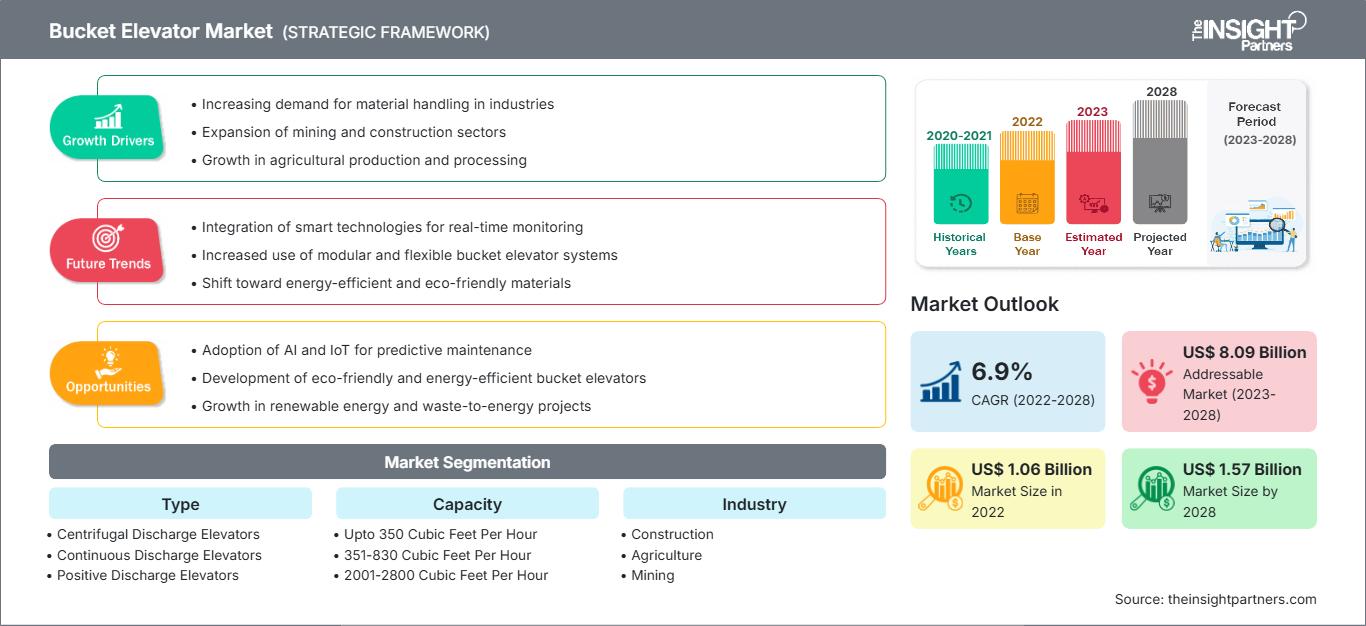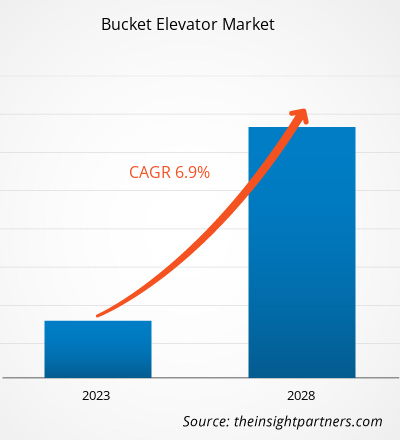Si prevede che il mercato degli elevatori a tazze raggiungerà i 1.571,40 milioni di dollari entro il 2028, rispetto ai 1.055,12 milioni di dollari del 2022; si prevede una crescita a un CAGR del 6,9% nel periodo 2022-2028.
Gli elevatori a tazze sono attrezzature a basso consumo energetico e poco ingombranti, utilizzate per trasportare prodotti in grandi e piccole quantità. Sono disponibili in una varietà di tipologie, design e stili per diverse applicazioni. Gli elevatori a tazze sono utilizzati principalmente per trasferire materiali da terra a luoghi in quota. Sono costruiti con una cinghia in cotone o gomma che scorre su una puleggia motrice situata nella parte superiore, mentre l'altra estremità è la puleggia condotta, situata nella parte inferiore all'interno di un involucro prefabbricato. Gli elevatori a tazze centrifughi sono il tipo di elevatore più comune utilizzato in molti settori per trasportare verticalmente solidi sfusi in polvere, come cereali, zucchero, sabbia e minerali. Il loro utilizzo è comune nei settori del cemento, del vetro, minerario, della produzione di energia, della biomassa, della carta e dell'edilizia, nonché nei grandi frantoi e in altre industrie di trasformazione.
Personalizza questo rapporto in base alle tue esigenze
Potrai personalizzare gratuitamente qualsiasi rapporto, comprese parti di questo rapporto, o analisi a livello di paese, pacchetto dati Excel, oltre a usufruire di grandi offerte e sconti per start-up e università
Mercato degli elevatori a tazze: Approfondimenti strategici

- Ottieni le principali tendenze chiave del mercato di questo rapporto.Questo campione GRATUITO includerà l'analisi dei dati, che vanno dalle tendenze di mercato alle stime e alle previsioni.
Potrai personalizzare gratuitamente qualsiasi rapporto, comprese parti di questo rapporto, o analisi a livello di paese, pacchetto dati Excel, oltre a usufruire di grandi offerte e sconti per start-up e università
Mercato degli elevatori a tazze: Approfondimenti strategici

- Ottieni le principali tendenze chiave del mercato di questo rapporto.Questo campione GRATUITO includerà l'analisi dei dati, che vanno dalle tendenze di mercato alle stime e alle previsioni.
Impatto della pandemia di COVID-19 sulla crescita del mercato degli elevatori a tazze
La pandemia di COVID-19 ha avuto un impatto drammatico sull'economia mondiale durante il suo picco nel 2020. La crisi ha ostacolato le attività commerciali in diversi settori. L'epidemia ha sconvolto diversi settori, come l'edilizia, l'alimentare, le bevande, la chimica e l'industria mineraria. Con il lockdown nella maggior parte dei paesi, i progetti di costruzione sono stati temporaneamente sospesi, costringendo gli appaltatori a cambiare il proprio modo di lavorare da un giorno all'altro. L'epidemia ha creato notevoli disagi nel settore edile. Un forte calo del commercio internazionale ha avuto un impatto negativo sulla crescita dell'economia globale. Chiusure di fabbriche e produzioni, divieti commerciali, interruzioni delle catene di approvvigionamento e delle attività di gestione degli acquisti, carenza di manodopera e restrizioni alla circolazione transfrontaliera per contrastare la diffusione della malattia hanno avuto un impatto negativo sull'attività delle aziende in tutto il mondo. L'impatto negativo della pandemia su diversi settori ha limitato la crescita del mercato degli elevatori a tazze. Tuttavia, le industrie hanno registrato una crescita significativa con l'allentamento delle restrizioni e la riapertura delle fabbriche nel 2021. Ora si stanno concentrando sempre di più sul miglioramento della larghezza di banda, della compatibilità e dell'efficienza attraverso l'adozione di tecnologie e investimenti. Sebbene il mercato globale degli elevatori a tazze abbia subito un impatto negativo a causa della pandemia di COVID-19 nel 2020, ha registrato una forte ripresa.
Approfondimenti di mercato - Mercato degli elevatori a tazze
L'impennata dei lavori di costruzione nei settori residenziale, commerciale e in altri settori ha stimolato la crescita dell'industria del cemento. Gli enti governativi stanno sempre più puntando sul supporto allo sviluppo edilizio e infrastrutturale. I produttori di cemento sono tra i maggiori clienti degli operatori del mercato degli elevatori a tazze. Hanno aggiornato i loro impianti per far fronte all'aumento della domanda di cemento, che ha incrementato l'installazione di elevatori a tazze. Nell'ottobre 2022, MDG America è stata selezionata per fornire allo stabilimento Drake Cement di Paulden, in Arizona, Stati Uniti, quattro elevatori a tazze a catena di alta qualità. Nel marzo 2021, UltraTech Cement Limited ha scelto AUMUND India per la fornitura di un pacchetto completo di attrezzature che includeva 46 elevatori a tazze a nastro. Il contratto includeva la fornitura di elevatori a tazze per l'alimentazione dei forni con altezze fino a 157 m, elevatori a tazze per la movimentazione delle materie prime, elevatori a tazze per la movimentazione di clinker e cemento (di varie dimensioni) ed elevatori a tazze a ricircolo con presse a rulli con capacità fino a 2.200 tonnellate all'ora (tph). Pertanto, la crescente adozione di elevatori a tazze nell'industria del cemento stimola la crescita del mercato degli elevatori a tazze.
Approfondimenti basati sulla tipologia
La tipologia di elevatore a tazze scelta dipende dall'applicazione a cui è destinato. Viene inoltre scelta per supportare il flusso di processo più efficiente. Il mercato degli elevatori a tazze, per tipologia, è segmentato in elevatori a scarico centrifugo, elevatori a scarico continuo ed elevatori a scarico positivo. Il segmento degli elevatori a scarico centrifugo ha rappresentato la quota di mercato maggiore nel 2021. Si prevede inoltre che registrerà il CAGR più rapido durante il periodo di previsione.
Il mercato degli elevatori a tazze è segmentato in base a tipologia, capacità, settore e area geografica. In base alla tipologia, il mercato è suddiviso in elevatori a scarico centrifugo, elevatori a scarico continuo ed elevatori a scarico positivo. In base alla capacità, il mercato degli elevatori a tazze è suddiviso in 350-830 piedi cubi all'ora, 2001-2800 piedi cubi all'ora, 831-2000 piedi cubi all'ora, oltre 2801 piedi cubi all'ora e sotto 350 piedi cubi all'ora. Per settore, il mercato è segmentato in edilizia, agricoltura, estrazione mineraria, alimentare, energia e servizi di pubblica utilità, carta e cellulosa e altri. In termini geografici, il mercato degli elevatori a tazze è segmentato in cinque regioni principali: Nord America, Europa, Asia Pacifico (APAC), Medio Oriente e Africa. Africa (MEA) e Sud America (SAM). BEUMER Group GmbH & Co KG, FEECO International Inc, Gough & Co (Engineering) Ltd, KWS Manufacturing Co Ltd, Motridal SpA, Skandia Elevator AB, Sukup Manufacturing Co, Satake Corp, Ryson International Inc e AGCO Corp sono tra i principali attori del mercato degli elevatori a tazze.
Mercato degli elevatori a tazze
Le tendenze regionali e i fattori che influenzano il mercato degli elevatori a tazze durante il periodo di previsione sono stati ampiamente spiegati dagli analisti di The Insight Partners. Questa sezione illustra anche i segmenti e la distribuzione geografica del mercato degli elevatori a tazze in Nord America, Europa, Asia-Pacifico, Medio Oriente e Africa, America meridionale e centrale.
Ambito del rapporto di mercato degli elevatori a tazze
| Attributo del rapporto | Dettagli |
|---|---|
| Dimensioni del mercato in 2022 | US$ 1.06 Billion |
| Dimensioni del mercato per 2028 | US$ 1.57 Billion |
| CAGR globale (2022 - 2028) | 6.9% |
| Dati storici | 2020-2021 |
| Periodo di previsione | 2023-2028 |
| Segmenti coperti |
By Tipo
|
| Regioni e paesi coperti | Nord America
|
| Leader di mercato e profili aziendali chiave |
|
Densità degli operatori del mercato degli elevatori a tazze: comprendere il suo impatto sulle dinamiche aziendali
Il mercato degli elevatori a tazze è in rapida crescita, trainato dalla crescente domanda degli utenti finali, dovuta a fattori quali l'evoluzione delle preferenze dei consumatori, i progressi tecnologici e una maggiore consapevolezza dei vantaggi del prodotto. Con l'aumento della domanda, le aziende stanno ampliando la propria offerta, innovando per soddisfare le esigenze dei consumatori e sfruttando le tendenze emergenti, alimentando ulteriormente la crescita del mercato.

- Ottieni il Mercato degli elevatori a tazze Panoramica dei principali attori chiave
Gli operatori del mercato degli elevatori a tazze si concentrano principalmente sul lancio di prodotti e sulle partnership per creare valore per il cliente.
- A dicembre 2022, Ryson International, Inc. ha lanciato una nuova gamma di elevatori per materiali sfusi, progettati per trasportare una varietà di materiali sfusi. I nuovi elevatori per materiali sfusi di Ryson combinano il trasporto verticale e orizzontale. Gli elevatori chiusi sono dotati di tazze pivottanti sovrapposte per contribuire a prevenire la fuoriuscita di prodotto e ridurre la presenza di detriti estranei.
- A settembre 2022, Muller Beltex BV, VAV Aandrijvingen BV e Bechtel GmbH hanno annunciato un'alleanza strategica per posizionarsi meglio sul mercato e fornire ai propri clienti materiali, conoscenze e servizi in modo migliore e più efficiente.
- Analisi storica (2 anni), anno base, previsione (7 anni) con CAGR
- Analisi PEST e SWOT
- Valore/volume delle dimensioni del mercato - Globale, Regionale, Nazionale
- Industria e panorama competitivo
- Set di dati Excel
Report recenti
Testimonianze
Motivo dell'acquisto
- Processo decisionale informato
- Comprensione delle dinamiche di mercato
- Analisi competitiva
- Analisi dei clienti
- Previsioni di mercato
- Mitigazione del rischio
- Pianificazione strategica
- Giustificazione degli investimenti
- Identificazione dei mercati emergenti
- Miglioramento delle strategie di marketing
- Aumento dell'efficienza operativa
- Allineamento alle tendenze normative




















 Ottieni un campione gratuito per - Mercato degli elevatori a tazze
Ottieni un campione gratuito per - Mercato degli elevatori a tazze